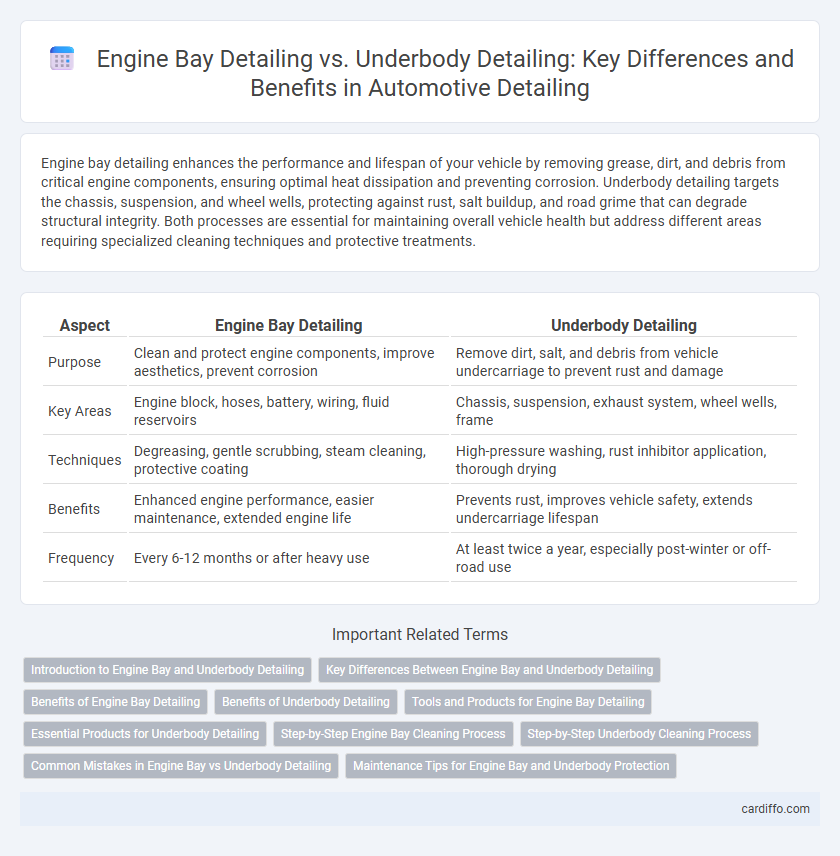Engine bay detailing enhances the performance and lifespan of your vehicle by removing grease, dirt, and debris from critical engine components, ensuring optimal heat dissipation and preventing corrosion. Underbody detailing targets the chassis, suspension, and wheel wells, protecting against rust, salt buildup, and road grime that can degrade structural integrity. Both processes are essential for maintaining overall vehicle health but address different areas requiring specialized cleaning techniques and protective treatments.
Table of Comparison
| Aspect | Engine Bay Detailing | Underbody Detailing |
|---|---|---|
| Purpose | Clean and protect engine components, improve aesthetics, prevent corrosion | Remove dirt, salt, and debris from vehicle undercarriage to prevent rust and damage |
| Key Areas | Engine block, hoses, battery, wiring, fluid reservoirs | Chassis, suspension, exhaust system, wheel wells, frame |
| Techniques | Degreasing, gentle scrubbing, steam cleaning, protective coating | High-pressure washing, rust inhibitor application, thorough drying |
| Benefits | Enhanced engine performance, easier maintenance, extended engine life | Prevents rust, improves vehicle safety, extends undercarriage lifespan |
| Frequency | Every 6-12 months or after heavy use | At least twice a year, especially post-winter or off-road use |
Introduction to Engine Bay and Underbody Detailing
Engine bay detailing involves the careful cleaning and conditioning of the engine compartment, targeting grime, grease, and debris to enhance performance and visual appeal. Underbody detailing focuses on removing dirt, salt, and corrosion from the vehicle's underside, crucial for preventing rust and prolonging structural integrity. Both detailing processes contribute significantly to vehicle maintenance, addressing distinct areas prone to build-up and wear.
Key Differences Between Engine Bay and Underbody Detailing
Engine bay detailing focuses on cleaning and protecting the engine compartment by removing grease, dirt, and grime from components such as hoses, belts, and battery terminals, ensuring optimal performance and preventing corrosion. Underbody detailing targets the vehicle's chassis, suspension, and wheel wells, eliminating accumulated road salt, mud, and debris to prevent rust and extend the life of critical structural parts. Both processes require specialized tools and cleaning agents but differ significantly in their approach due to the distinct areas and materials involved.
Benefits of Engine Bay Detailing
Engine bay detailing enhances vehicle performance by removing dirt, grease, and grime that can cause overheating and mechanical issues. It improves the longevity of engine components by preventing corrosion and wear, while also making it easier to spot leaks and potential problems early. A clean engine bay increases resale value by showcasing well-maintained vehicle care to potential buyers.
Benefits of Underbody Detailing
Underbody detailing protects your vehicle's frame and suspension components by removing corrosive substances like road salt, mud, and grime that accumulate over time. This process extends the lifespan of critical parts and prevents rust and damage, enhancing overall safety and vehicle integrity. Regular underbody cleaning also improves performance by maintaining optimal functionality of steering and brake systems concealed beneath the car.
Tools and Products for Engine Bay Detailing
Engine bay detailing relies heavily on specialized tools such as soft-bristle brushes, plastic applicators, and precision microfiber cloths to carefully remove grease and dirt without damaging delicate components. High-quality degreasers and engine-safe cleaners formulated to break down oil and grime without harming electrical parts are essential for effective engine bay cleaning. Additionally, protectants like silicone-based sprays help to preserve plastic and rubber surfaces, ensuring a clean and well-maintained engine bay appearance.
Essential Products for Underbody Detailing
Underbody detailing requires specialized products such as rust inhibitors, high-pressure water washers, and degreasers designed to remove mud, salt, and road grime effectively. Protective coatings like rubberized undercoating sprays safeguard metal components from corrosion and abrasions caused by exposure to moisture and debris. Using long-lasting sealants and rust preventatives is essential for maintaining the structural integrity of the vehicle's chassis and suspension system.
Step-by-Step Engine Bay Cleaning Process
Engine bay detailing involves systematically removing dirt, grease, and grime from the engine compartment using a combination of degreasers, soft brushes, and low-pressure water sprays to avoid damage to electrical components. Key steps include disconnecting the battery, covering sensitive parts with plastic bags, applying engine degreaser, agitating with brushes, rinsing carefully, and drying with microfiber towels or compressed air to prevent corrosion. This process protects engine components, improves vehicle appearance, and enhances the overall maintenance of the engine bay, contrasting with underbody detailing that focuses on removing road salt, mud, and rust-proofing treatments.
Step-by-Step Underbody Cleaning Process
Thorough underbody detailing begins with lifting the vehicle to access all areas beneath the chassis, followed by removing loose dirt and debris using a high-pressure washer to prevent grime buildup and corrosion. Detergent application targets grease and road salt, which are then scrubbed with a stiff brush before rinsing thoroughly to ensure all residues are eliminated. Final steps involve drying the underbody with compressed air or cloth and applying an underbody protectant to inhibit rust and extend the vehicle's lifespan.
Common Mistakes in Engine Bay vs Underbody Detailing
Common mistakes in engine bay detailing include using excessive water that can damage electrical components and neglecting to protect sensitive areas like the battery and exposed wiring. Underbody detailing errors often involve missing corrosion-prone areas and failing to thoroughly remove accumulated road salt and grime, which can accelerate rust. Proper technique and the use of specialized cleaners are essential to avoid these pitfalls in both engine bay and underbody detailing.
Maintenance Tips for Engine Bay and Underbody Protection
Engine bay detailing requires thorough cleaning of oil, grease, and dirt buildup to prevent corrosion and ensure optimal engine performance, using degreasers and careful water avoidance around electrical components. Underbody detailing involves removing mud, salt, and road grime to protect against rust and extend the vehicle's lifespan, often followed by applying rust-proof coatings or sealants. Regular inspections and timely maintenance with proper cleaning agents enhance both engine bay efficiency and underbody durability, safeguarding key mechanical parts and structural integrity.
Engine Bay Detailing vs Underbody Detailing Infographic

 cardiffo.com
cardiffo.com